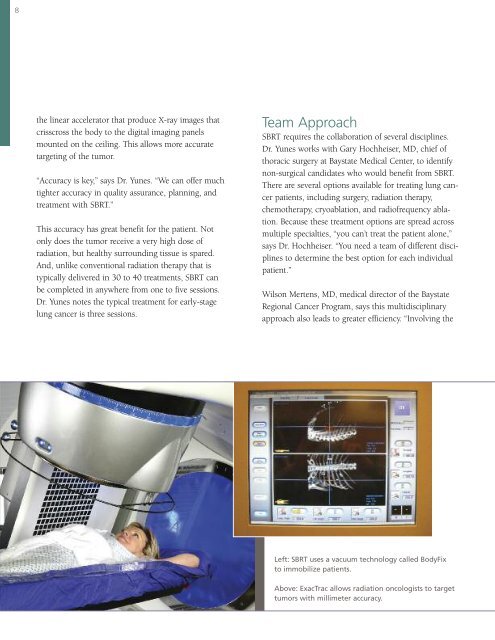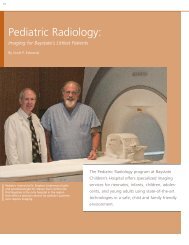Al Pha Sights - Baystate Health
Al Pha Sights - Baystate Health
Al Pha Sights - Baystate Health
You also want an ePaper? Increase the reach of your titles
YUMPU automatically turns print PDFs into web optimized ePapers that Google loves.
8<br />
the linear accelerator that produce X-ray images that<br />
crisscross the body to the digital imaging panels<br />
mounted on the ceiling. This allows more accurate<br />
targeting of the tumor.<br />
“Accuracy is key,” says Dr. Yunes. “We can offer much<br />
tighter accuracy in quality assurance, planning, and<br />
treatment with SBRT.”<br />
This accuracy has great benefit for the patient. Not<br />
only does the tumor receive a very high dose of<br />
radiation, but healthy surrounding tissue is spared.<br />
And, unlike conventional radiation therapy that is<br />
typically delivered in 30 to 40 treatments, SBRT can<br />
be completed in anywhere from one to five sessions.<br />
Dr. Yunes notes the typical treatment for early-stage<br />
lung cancer is three sessions.<br />
Team Approach<br />
SBRT requires the collaboration of several disciplines.<br />
Dr. Yunes works with Gary Hochheiser, MD, chief of<br />
thoracic surgery at <strong>Baystate</strong> Medical Center, to identify<br />
non-surgical candidates who would benefit from SBRT.<br />
There are several options available for treating lung cancer<br />
patients, including surgery, radiation therapy,<br />
chemotherapy, cryoablation, and radiofrequency ablation.<br />
Because these treatment options are spread across<br />
multiple specialties, “you can’t treat the patient alone,”<br />
says Dr. Hochheiser. “You need a team of different disciplines<br />
to determine the best option for each individual<br />
patient.”<br />
Wilson Mertens, MD, medical director of the <strong>Baystate</strong><br />
Regional Cancer Program, says this multidisciplinary<br />
approach also leads to greater efficiency. “Involving the<br />
Left: SBRT uses a vacuum technology called BodyFix<br />
to immobilize patients.<br />
Above: ExacTrac allows radiation oncologists to target<br />
tumors with millimeter accuracy.

















